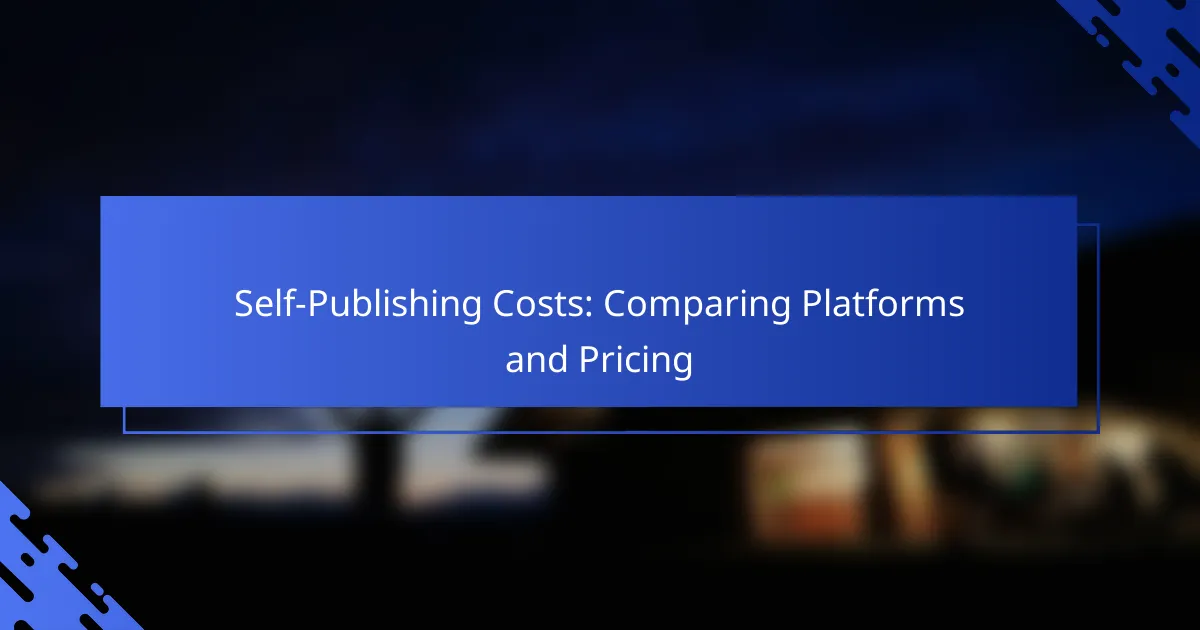Self-publishing offers authors a range of platforms, each with varying costs that can significantly influence their overall investment and potential earnings. By examining factors such as setup fees, printing costs, and distribution expenses, authors can make informed decisions that align with their budget and publishing goals.

What Are the Self-Publishing Costs on Major Platforms?
Self-publishing costs vary significantly across major platforms, impacting authors’ potential earnings and budget considerations. Understanding these costs helps authors choose the right platform for their publishing needs.
Amazon Kindle Direct Publishing (KDP) fees
Amazon KDP operates on a royalty model, offering authors 35% or 70% royalties based on the book’s price and distribution options. For eBooks priced between $2.99 and $9.99, authors typically earn 70% royalties, while books outside this range earn 35%.
Additionally, KDP charges a delivery fee based on file size, which can range from a few cents to a couple of dollars. Authors should factor in these costs when pricing their books to ensure profitability.
IngramSpark pricing structure
IngramSpark charges a setup fee for each title, typically around $49, plus additional fees for print copies and distribution. Authors can expect to pay for both eBook and print book distribution, which can add up if multiple formats are published.
While IngramSpark offers wider distribution options, including libraries and bookstores, authors should consider the upfront costs versus potential sales reach. Regular promotional codes can reduce setup fees, making it more affordable.
Smashwords cost breakdown
Smashwords does not charge upfront fees for publishing, but it takes a commission of approximately 10% on sales. This platform is known for its extensive distribution network, which includes major retailers and libraries.
Authors should be aware that while there are no initial costs, the commission can impact overall earnings. Smashwords also offers various marketing tools that can help boost visibility without additional costs.
Draft2Digital fees
Draft2Digital is free to use, taking a 10% cut from sales as its fee. This platform simplifies the publishing process and offers automatic formatting for eBooks, which can save authors time and money.
With no upfront costs, Draft2Digital is an attractive option for new authors. However, authors should consider the commission when setting their pricing to maintain desired profit margins.
Apple Books publishing costs
Apple Books does not charge a fee to publish, but it retains a 30% commission on sales. Authors can set their own prices, but should keep in mind that the commission can significantly affect earnings.
Apple Books is known for its user-friendly interface and access to a large audience. Authors should leverage promotional opportunities within the platform to maximize visibility and sales potential.
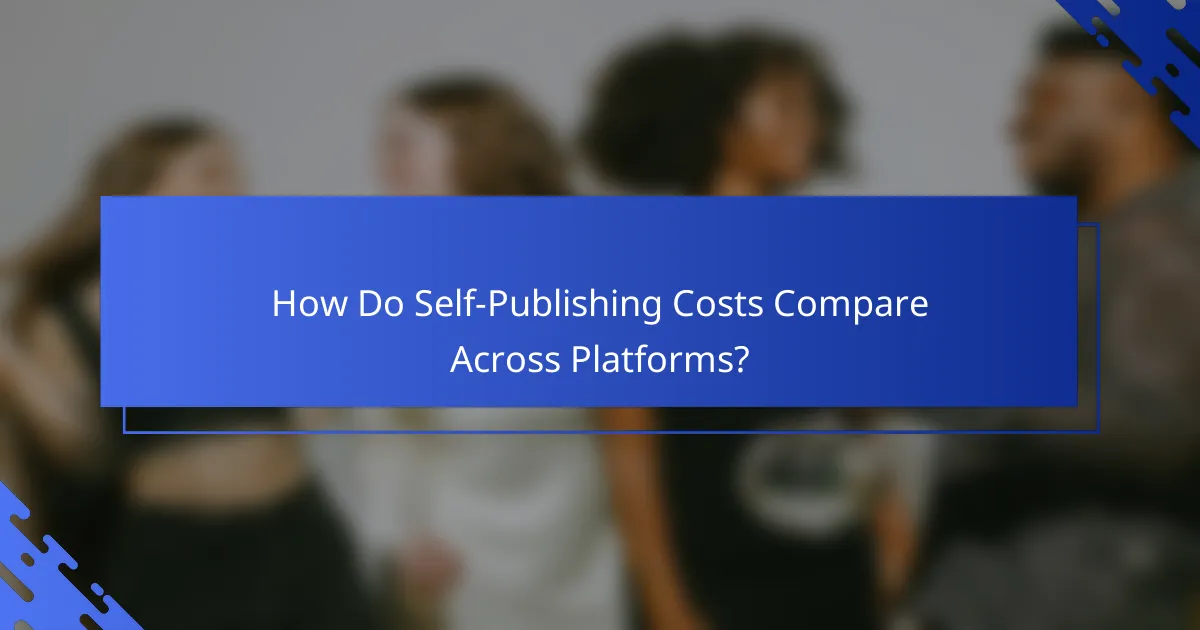
How Do Self-Publishing Costs Compare Across Platforms?
Self-publishing costs vary significantly across different platforms, impacting your overall investment and potential earnings. Key factors include setup fees, printing costs, and distribution expenses, which can influence your choice of platform.
Cost comparison table
When evaluating self-publishing platforms, it’s helpful to compare their costs side by side. Below is a simplified table highlighting typical expenses associated with popular platforms:
| Platform | Setup Fee | Printing Cost (per copy) | Distribution Fee |
|---|---|---|---|
| Amazon KDP | $0 | $2-$5 | 15% of royalties |
| IngramSpark | $49 | $3-$6 | 20% of royalties |
| Smashwords | $0 | N/A | 10% of royalties |
Royalty rates analysis
Royalty rates are crucial in determining your earnings from self-publishing. Most platforms offer royalties ranging from 35% to 70%, depending on the pricing and distribution choices you make. For instance, Amazon KDP offers a 70% royalty rate for eBooks priced between $2.99 and $9.99, while lower-priced books earn a 35% royalty.
Consider the implications of these rates on your overall profits. Higher royalty rates can significantly enhance your earnings, but they often come with specific pricing requirements or distribution limitations.
Print vs. digital publishing costs
Print and digital publishing costs differ notably, impacting your budget and pricing strategy. Print costs typically include setup fees, printing expenses, and shipping, which can add up to several dollars per copy. In contrast, digital publishing usually incurs minimal upfront costs, primarily related to formatting and distribution.
When deciding between print and digital, consider your target audience and sales strategy. Digital formats may have lower barriers to entry and wider reach, while print can appeal to readers who prefer physical books. Balancing both formats can maximize your potential revenue.
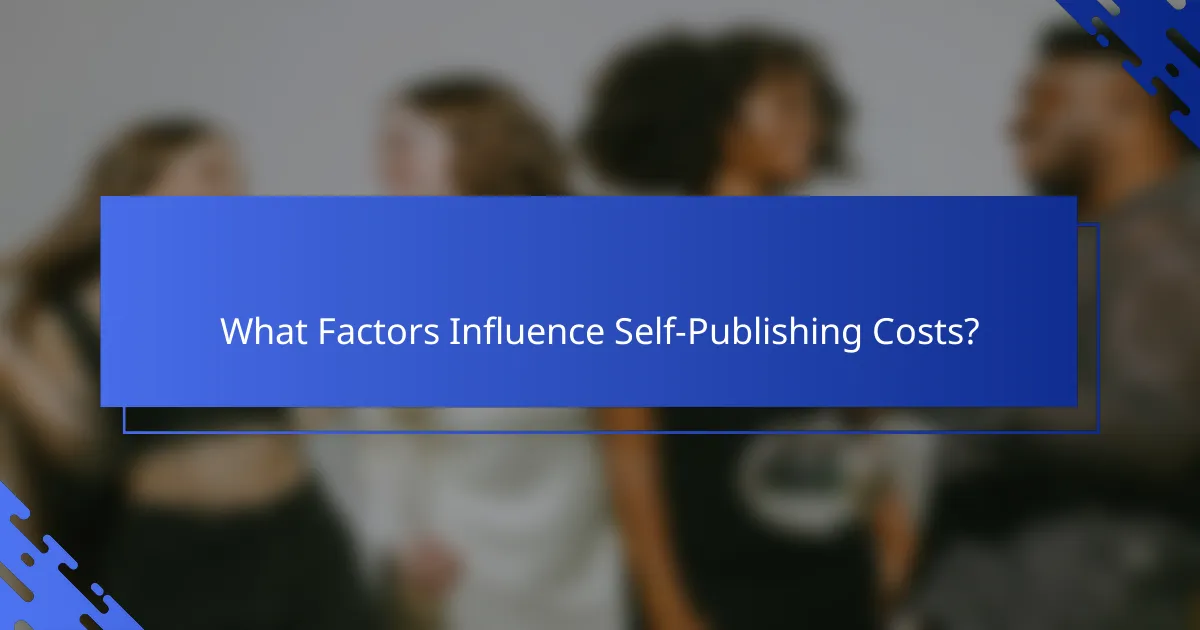
What Factors Influence Self-Publishing Costs?
Self-publishing costs can vary significantly based on several key factors, including editing, design, and marketing. Understanding these elements helps authors budget effectively and make informed decisions about their publishing journey.
Editing and proofreading expenses
Editing and proofreading are crucial for producing a polished manuscript. Costs can range from a few hundred to several thousand dollars, depending on the length of the book and the level of editing required, such as developmental, copyediting, or proofreading.
Authors should consider hiring professionals with experience in their genre to ensure quality. It’s often wise to allocate around 10-15% of your total budget for editing to achieve a well-crafted final product.
Cover design costs
A compelling cover design is essential for attracting readers and can significantly impact sales. Prices for cover design can vary widely, typically ranging from $100 for basic designs to over $1,000 for custom artwork by experienced designers.
When selecting a designer, consider their portfolio and previous work in your genre. Investing in a quality cover can yield a strong return on investment, as it plays a critical role in a book’s marketability.
Marketing and promotion budgets
Marketing and promotion are vital for reaching potential readers and can involve various strategies, from social media advertising to book launch events. Budgets for marketing can start at a few hundred dollars and go up to several thousand, depending on the methods chosen.
It’s advisable to set aside at least 20-30% of your total budget for marketing efforts. Focus on building an online presence and engaging with your target audience to maximize your promotional impact.
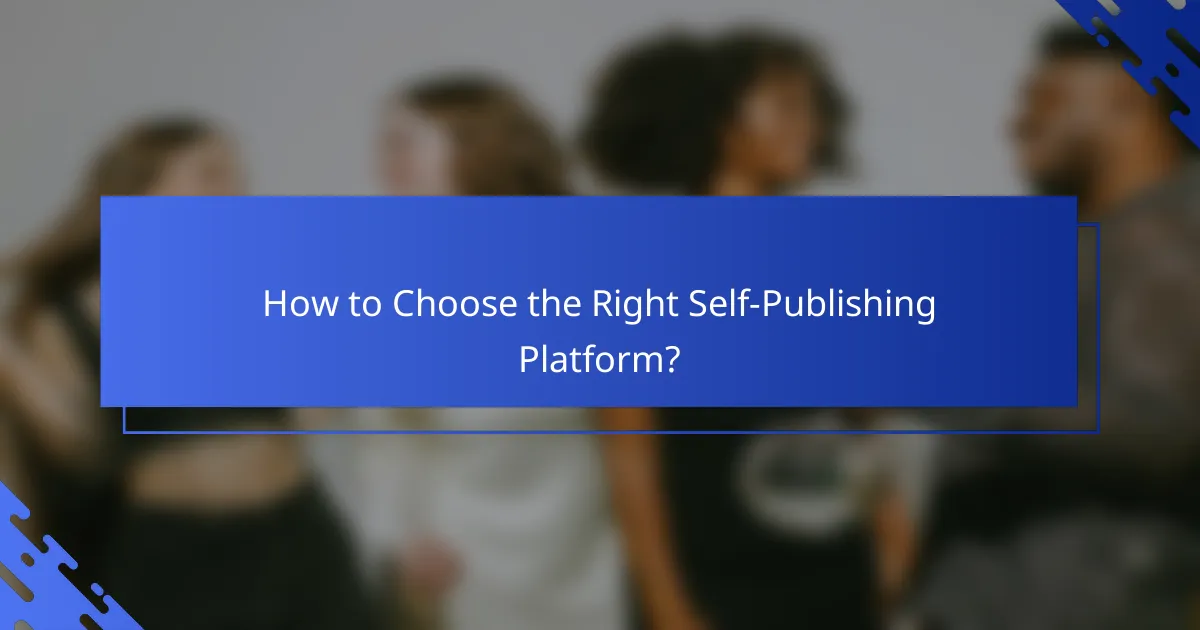
How to Choose the Right Self-Publishing Platform?
Choosing the right self-publishing platform involves evaluating key features, user experiences, and distribution options. Consider what matters most for your goals, such as ease of use, cost, and the reach of your book.
Platform features comparison
Different self-publishing platforms offer various features that can significantly impact your publishing experience. Look for tools that simplify formatting, cover design, and marketing. Some platforms provide built-in analytics, while others may offer more extensive customization options.
For instance, platforms like Amazon Kindle Direct Publishing (KDP) are known for their user-friendly interface and extensive reach, while others like IngramSpark may provide better print quality and distribution options. Weigh the pros and cons based on your specific needs.
User reviews and experiences
User reviews can provide valuable insights into the strengths and weaknesses of each self-publishing platform. Look for feedback on customer service, ease of use, and the overall publishing process. Websites like Goodreads and dedicated forums can be useful for gathering diverse opinions.
Pay attention to recurring themes in reviews, such as issues with royalties or difficulties in navigating the platform. This information can help you avoid potential pitfalls and select a platform that aligns with your expectations.
Distribution options analysis
Distribution options are crucial when selecting a self-publishing platform, as they determine how widely your book will reach readers. Some platforms, like KDP, primarily focus on eBook distribution, while others, such as Lulu or IngramSpark, offer extensive print and eBook distribution networks.
Consider whether you want to distribute your book globally or focus on specific markets. Additionally, check for options like expanded distribution, which can help your book reach libraries and bookstores. Understanding these options will help you maximize your book’s visibility and sales potential.
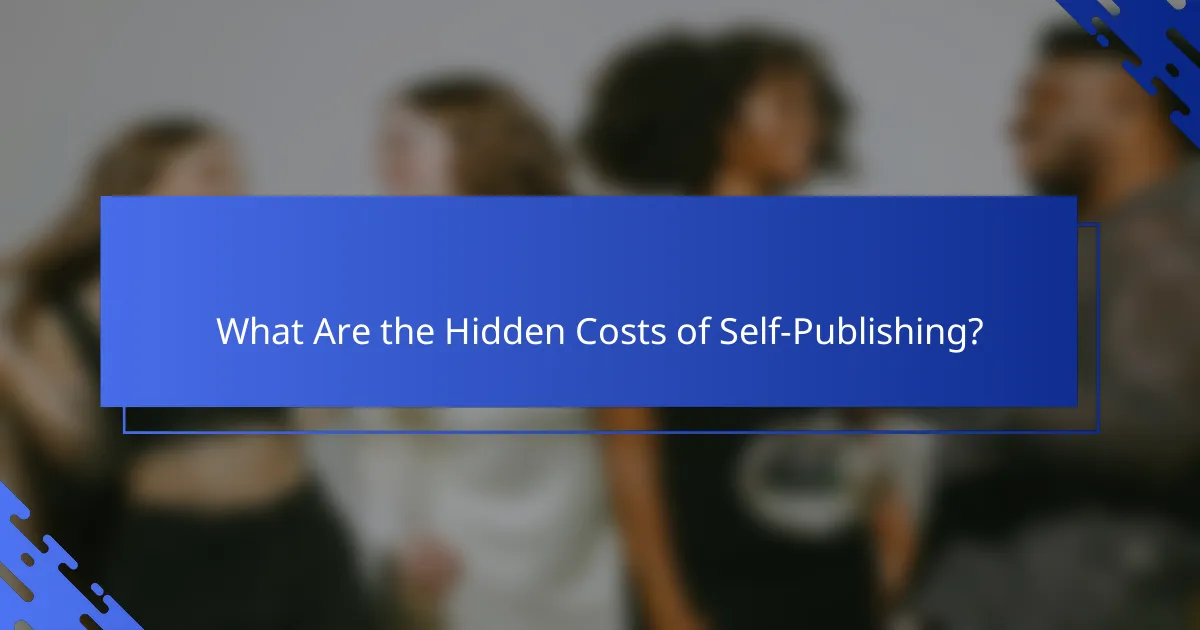
What Are the Hidden Costs of Self-Publishing?
Hidden costs in self-publishing can significantly impact your budget and overall success. These expenses often include fees for ISBNs, copyright registration, print-on-demand services, and ongoing marketing efforts that authors may overlook initially.
ISBN and copyright registration fees
Obtaining an ISBN (International Standard Book Number) is essential for selling your book through retailers and libraries. In the U.S., a single ISBN can cost around $125, while bulk purchases may reduce the price per unit. Copyright registration, which protects your work legally, typically costs between $35 and $55 if filed online.
Consider that some self-publishing platforms offer free ISBNs, but these may limit your control over the book’s rights and distribution. Weigh the benefits of investing in your own ISBN against the potential restrictions of platform-provided options.
Print-on-demand costs
Print-on-demand (POD) services allow you to print copies of your book as orders come in, reducing upfront costs. However, each book printed incurs a base cost, which can range from a few dollars to over $10 depending on factors like page count and binding type. Additionally, platforms may take a percentage of your sales.
It’s crucial to calculate your pricing strategy to ensure profitability. Consider setting your retail price to cover POD costs while remaining competitive. Research various POD providers to find the best rates and services that meet your needs.
Ongoing marketing expenses
Marketing is vital for self-published authors, but it often comes with ongoing costs. These can include paid advertising, social media promotions, and professional services like cover design or website development. Budgeting for marketing can range from a few hundred to several thousand dollars, depending on your strategy.
To manage these expenses effectively, create a marketing plan that outlines your goals and allocates funds accordingly. Focus on cost-effective strategies such as building an email list or leveraging social media platforms to engage with your audience without overspending.
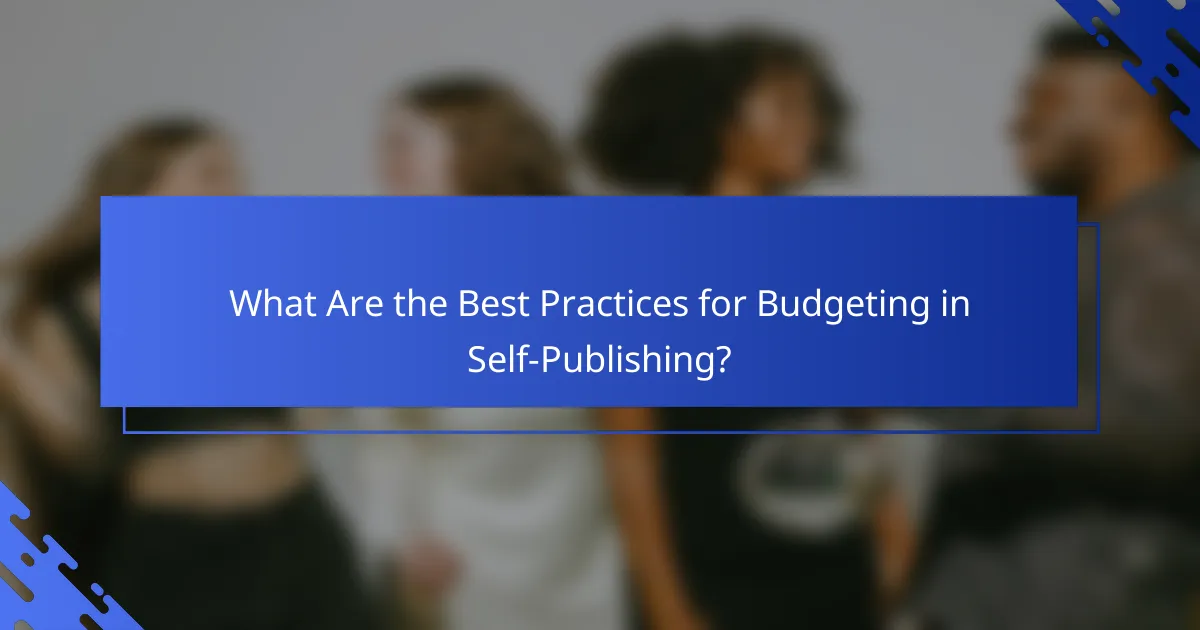
What Are the Best Practices for Budgeting in Self-Publishing?
Effective budgeting in self-publishing involves understanding the various costs associated with the process and planning accordingly. Key practices include researching platform fees, estimating production costs, and setting aside funds for marketing.
Understanding Platform Fees
Different self-publishing platforms have varying fee structures, which can significantly impact your budget. Common fees include upfront costs, royalties, and distribution charges. For example, platforms like Amazon Kindle Direct Publishing take a percentage of your sales, while others may charge a flat fee for publishing.
When choosing a platform, consider not only the fees but also the services offered. Some platforms provide additional support like marketing tools or formatting assistance, which can save you time and money in the long run.
Estimating Production Costs
Production costs encompass editing, cover design, and formatting, which are crucial for a professional-looking book. Depending on the quality and experience of the professionals you hire, these costs can range from a few hundred to several thousand dollars. For instance, hiring a freelance editor might cost anywhere from $500 to $2,000.
To manage these expenses, consider getting quotes from multiple service providers and comparing their portfolios. Investing in quality production can lead to better sales and reviews, making it a worthwhile expenditure.
Setting Aside Marketing Funds
Marketing is essential for the success of your self-published book, and budgeting for it is critical. Allocate a portion of your budget for promotional activities, such as social media advertising, book launch events, or author website development. A reasonable starting point might be 10-20% of your total budget.
Be strategic with your marketing funds by focusing on channels that best reach your target audience. Experimenting with different marketing tactics can help you identify what works best without overspending.
